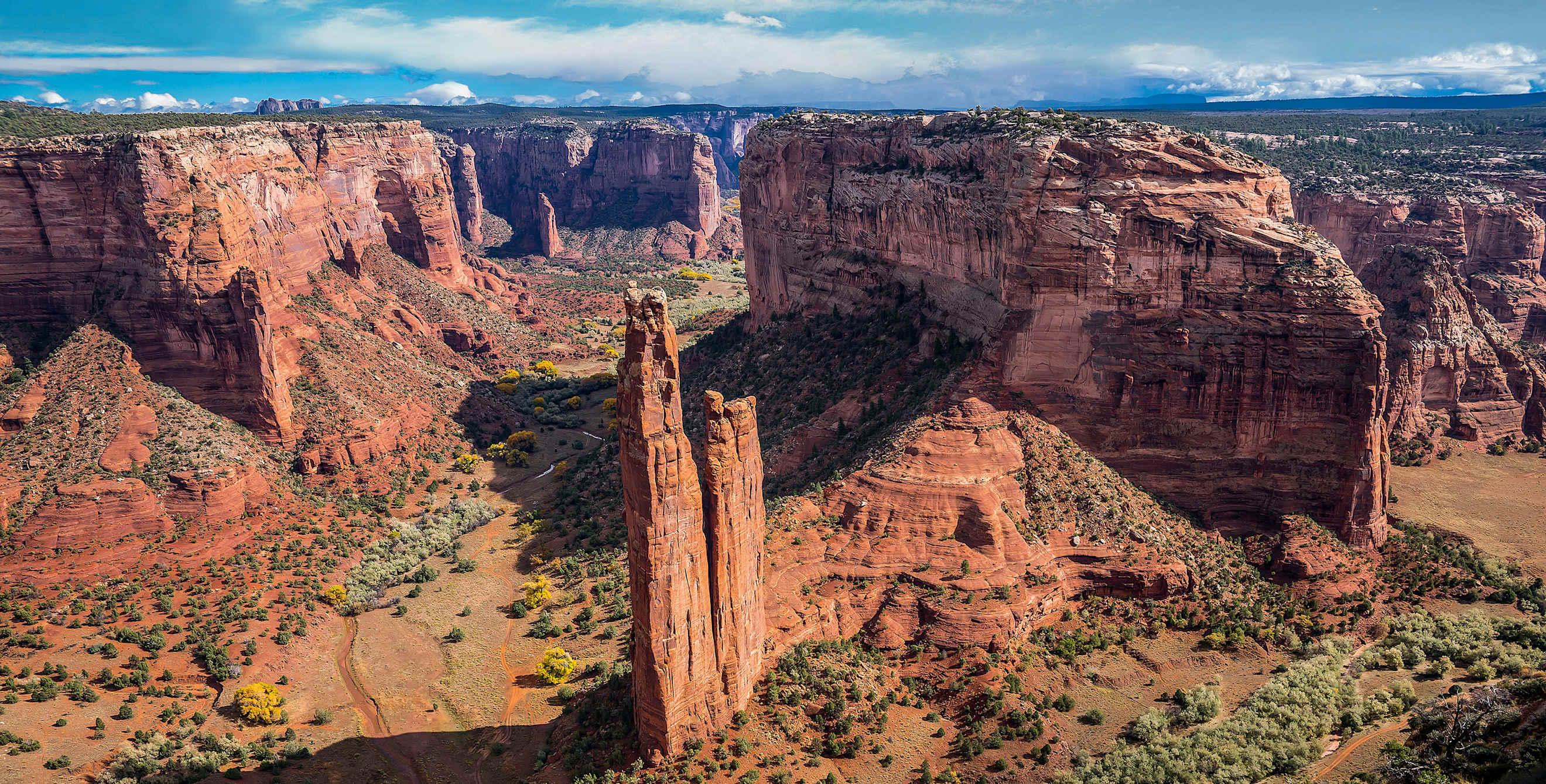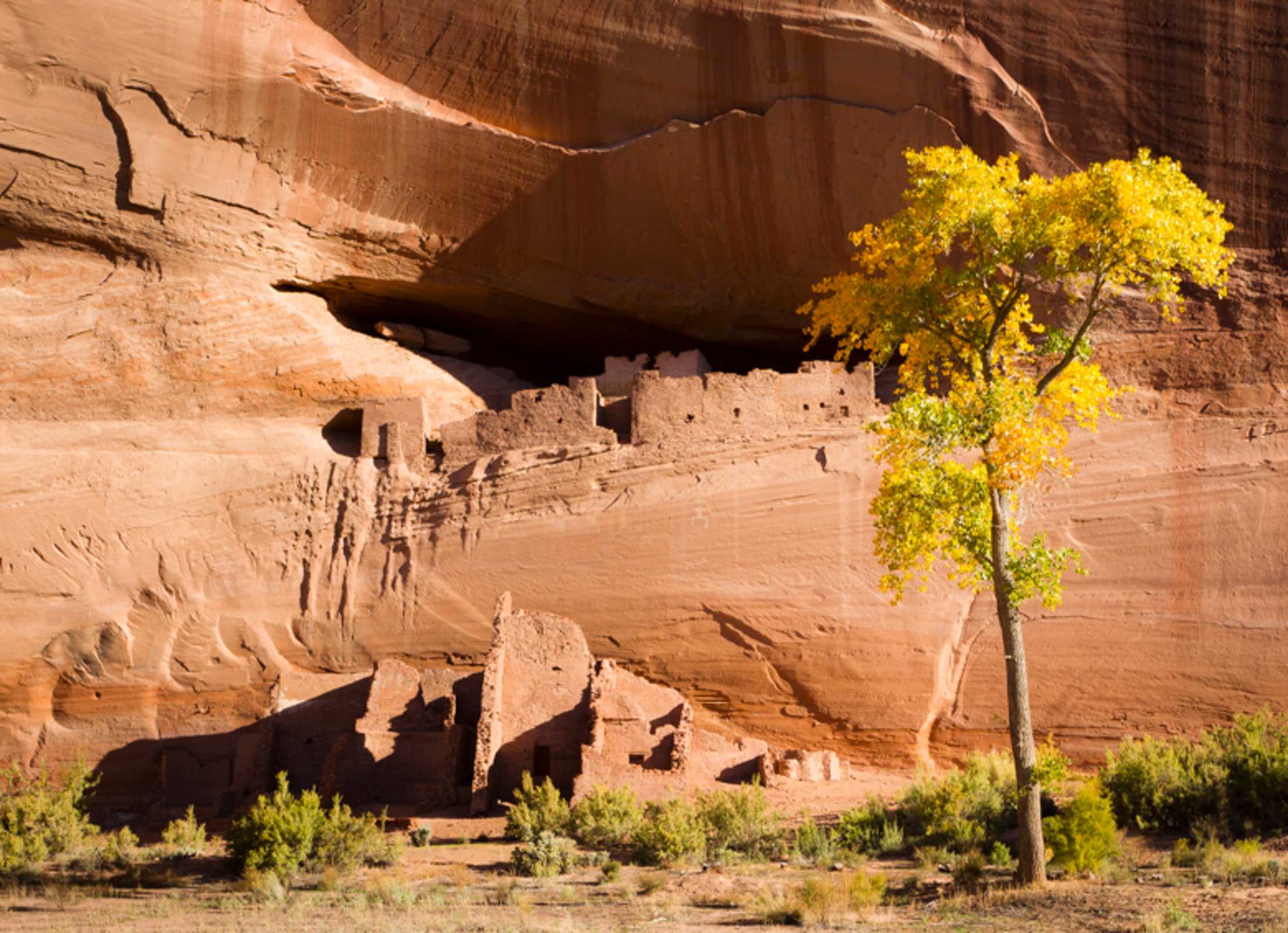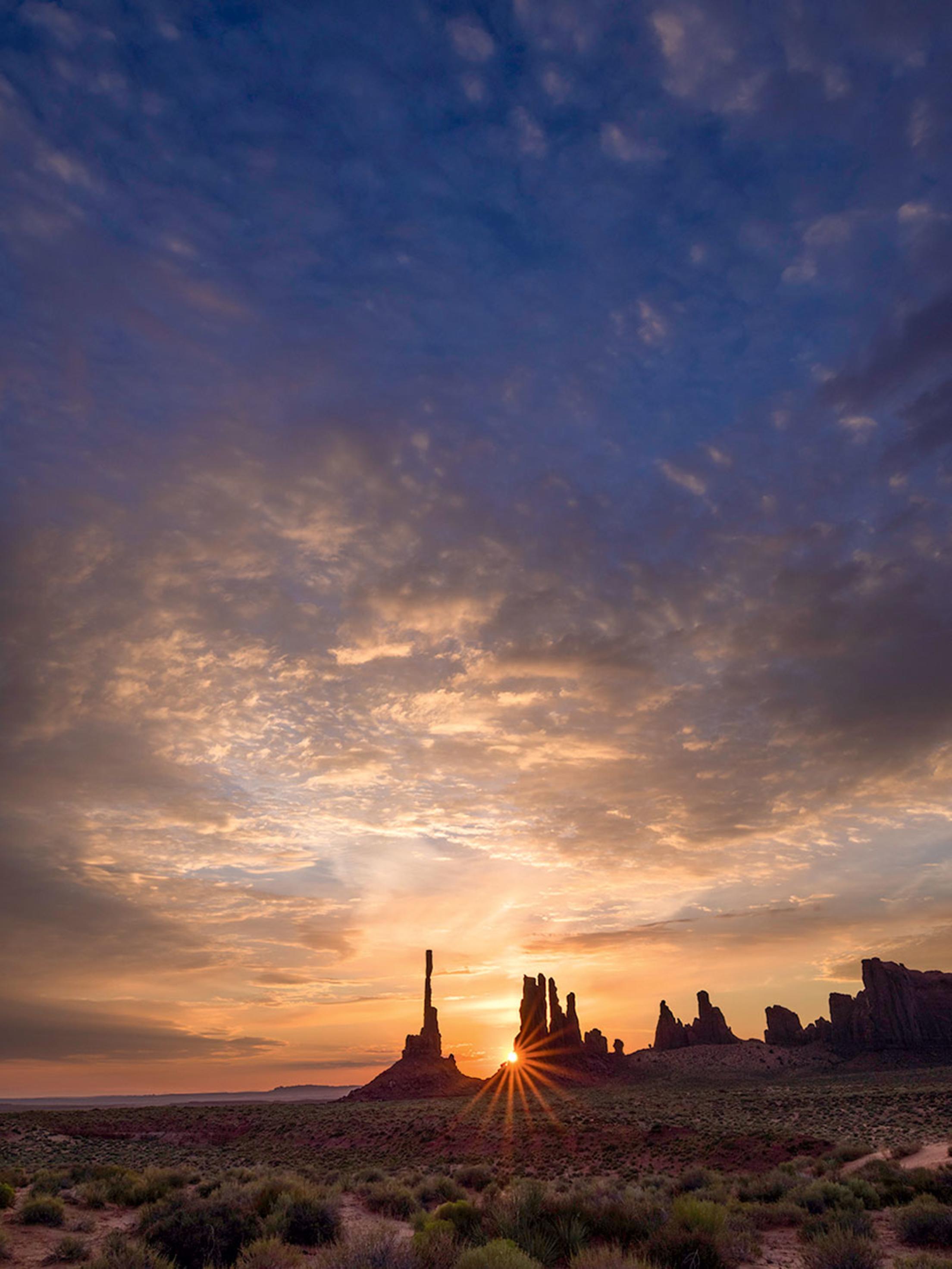
Fall Trip to Canyon de Chelly, Arizona
A verdant valley, deep in the Arizona desert, sustains an ancient way of life.

From the south rim, Canyon de Chelly looks impenetrable. Sheer sandstone cliffs plunge hundreds of feet to the valley floor below. Yet a sign at the overlook where I've parked assures me that, preposterously, there is a way to go from here down to there on foot. And indeed, in a nook of the canyon I find a tunnel that leads to a sketchy path—a prehistoric trail, sometimes little more than handholds and toeholds, used for centuries by sheepherders.
Now, in the late afternoon, most visitors have dispersed and the Navajo people who call the canyon home have the run of the place. I mean that literally: As I descend, at least a dozen joggers pass me at a trot, most with headphones in their ears. Me, I take a more leisurely pace so I can absorb my surroundings at the end of this beautiful October day—rust-colored, 600-foot cliffs; a cloudless sky; cottonwoods vibrant with ochers and golds.
After finally making it to the bottom of the trail, I walk out onto the canyon floor, past an old hogan and over to a south-facing cliff where the ancient stone towers of the White House Ruin have stood for hundreds of years. Despite some raggedy edges, their grandeur is undimmed. I can still see wooden beams, spooky dark windows, and the mud plaster that was hand-patted centuries ago.
In the hundreds of square miles of canyons that sprawl through the Southwest, Canyon de Chelly, about a five-hour drive northeast of Phoenix, is singular. Human beings have lived here for 5,000 years, making it one of the oldest inhabited places in the Colorado Plateau. The canyon is filled with the stories of its residents: the nomads who left faint petroglyphs thousands of years ago, the Ancestral Puebloans who built magnificent stone palaces around a.d. 1000 to 1300, and the Navajo who live here today.
The canyon is beautiful in any season, but to my mind autumn is the best. The weather is crisp, cool, and dry, with skies that are often still and cloud free. The summer crowds have ebbed and rich foliage shimmers in the bright sun. At this time of year, Navajo families harvest corn, squash, and pumpkins; sell their bounty at local fairs; and move their livestock out of the canyons and onto the rims for winter pasturing.

Conflict and Beauty
The Navajo arrived at Canyon de Chelly from the north in the 1700s. In the 1860s, after years of conflict between the Navajo and Anglo-American settlers in the region, the U.S. Army enlisted Kit Carson to chase the residents out of the canyon, forcing them to make the infamous Long Walk to Fort Sumner, N.M. Many died during the brutal 300-mile trek. The survivors suffered internment in New Mexico for more than three years before returning home to find their sheep had been killed and their farms destroyed.
In the decades that followed, the Navajo of Canyon de Chelly were able to rebuild and shape peaceful lives for themselves—growing crops, raising sheep, and bartering rugs and other crafts at local trading posts. Now some 80 to 100 families live in Canyon de Chelly National Monument, which is comanaged by the park service and the Navajo Nation.
The monument, established in 1931, encompasses its namesake canyon as well as Canyon del Muerto and several tributary canyons. Two scenic drives wend around the rims, and overlooks offer views into the chasms. Visitors can hike from one of the south rim overlooks down into the valley, as I did, as far as the White House Ruin. More extensive explorations require the company of a park ranger or a Navajo guide.
A day after my hike into the valley, I opt for the latter, hiring James Yazzie to give me a Jeep tour. His family has lived here for at least 10 generations, and though he now resides in nearby Chinle, Arizona, the 64-year-old grandfather still spends as much time here as he can. "On a map, Canyon de Chelly is a dot," he says when he picks me up in the morning at my hotel. "But to me it's huge."
For our five-hour tour, we decide to travel about 20 miles up Canyon de Chelly to Spider Rock, an 850-foot-tall pinnacle that the Navajo hold sacred. The route up the canyon is rough. Tracks braid and dip through cottonwood groves and wide sandy washes. Yazzie seems to prefer the bumpiest route. "It's not my Jeep," he says with a grin. (His nephew owns the company.)
Soon, the canyon's treasures reveal themselves. We admire stone ruins and a rock mural dating back at least 2,000 years. Few visitors venture past the White House Ruin, and we are utterly alone as Yazzie steers through cottonwoods so saturated with October colors they form glowing tunnels.
Yazzie is an excellent guide. Storytelling might as well be a sport among the Navajo; after stopping the Jeep under the towering red needle of Spider Rock, he engages in it with gusto. He tells me how the First People emerged from inside the earth and how Spider Woman—who is said to live at the top of the spire—gave them the gift of weaving. Yazzie's sister, a weaver, makes offerings here.
From where we're parked, in the shadow of Spider Rock, I can see the ruins of a fort from the Long Walk as well as colorful markers for an upcoming, locally hosted ultramarathon. (Perhaps that explains those joggers I saw the day before.) On this crisp fall day, Canyon de Chelly is doing what it does best: connecting the traveler with this landscape and its people, with the present and the past.

In and Around the Canyon
The Basics
Canyon de Chelly National Monument lies about 300 miles northeast of Phoenix and 230 miles northwest of Albuquerque, New Mexico. At the mouth of the canyon, the monument's welcome center offers books, gifts, vintage photos, a video about the history of the canyon, and other exhibits. Just south of there, Thunderbird Lodge is a venerable trading post that still sells Navajo rugs, jewelry, and pottery.
Seeing the Canyon
Without a guide, travelers can drive two scenic rim routes in the monument. One winds along the south rim and leads to seven overlooks, which provide views of Spider Rock. The other follows the north rim of Canyon del Muerto, from which you can see the Antelope House Ruin and the Mummy Cave Ruin.
The only way to travel into the canyon without a guide is to hike the 2.5-mile round-trip trail to the White House Ruin. It's best in early morning or late afternoon.
To see the interior of the canyon, hire a Navajo guide with a four-wheel-drive vehicle. You can find a list of authorized tour operators on the monument website. One of them, Beauty Way Jeep Tours, runs trips that range from three hours to several days as well as hiking and camping excursions.
Nearby Attractions
The Junction Restaurant has the best food in Chinle, Arizona, including Navajo tacos loaded with chiles.
About 95 miles north of Canyon de Chelly, Monument Valley Navajo Tribal Park is home to magnificent red sandstone buttes made famous in classic westerns. Today visitors can roll through the park on a 17-mile scenic drive or hire a guide through a service such as Navajo Spirit Tours.
South of Canyon de Chelly, the Hubbell Trading Post is a national historic site and the oldest operating trading post on Navajo land. Peruse rugs, baskets, and jewelry while admiring the building's stone-and-beam architecture.